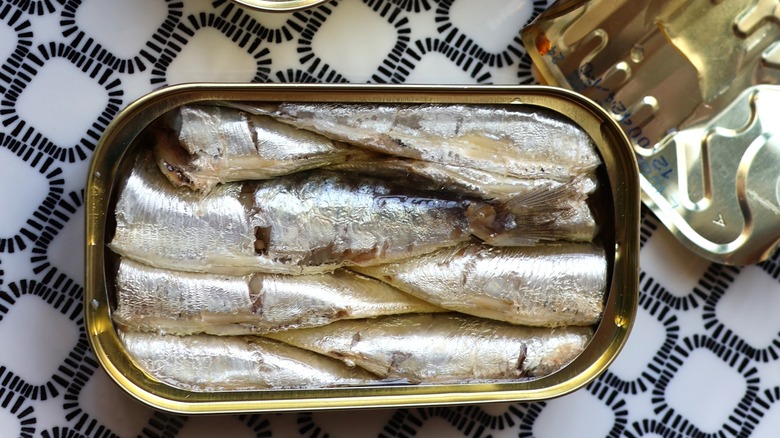The Fish Swap You Didn't Know Your Caesar Salad Needed
We may receive a commission on purchases made from links.
If you've never made Caesar salad dressing yourself, you may not know this particular dressing is rather fishy. The quickest, no-frills recipe involves whisking together minced anchovies, garlic cloves, mayonnaise (or egg yolks), parmesan, lemon juice, Worcestershire sauce, and a few other bits and bobs. If you're not an anchovy fan, you're not alone. The original recipe from restaurateur Caesar Cardini only used Worcestershire instead of anchovy paste, and Caesar salad purists may insist on making it this way. However, if you're mildly adventurous you might enjoy using sardines instead of anchovies in your homemade salad.
Sardines and anchovies may be similar-looking fish to the untrained landlubber, but in terms of flavor, sardines are typically more subtle and buttery, and they taste vaguely similar to tuna. Meanwhile, most anchovies have a stronger salty flavor because of the way they're cured before packaging. In many cases, you can't easily substitute them for each other because of this. Caesar salads are an exception where both fish work fairly well, because sardines blend very cleanly into the rich flavors of the parmesan and eggs. As long as you avoid over-dressing your romaine lettuce and croutons once it's done, you'll have some restaurant quality Caesar salad in front of you.
Making a Caesar salad with sardines
To mix sardines into homemade Caesar salad dressing, you don't need very many. The average Caesar salad would need about three anchovy filets, which are boneless strips of meat from the fish. Your average sardine is larger than an anchovy, and a single sardine filet can work as a substitute for the usual three anchovies. If you're worried about bones, you can fillet tiny fish like anchovies using just your hands, while filleting a larger sardine can require a knife or scissors. Once you've got your boneless fish meat ready, you mince or mash it before combining it with the other dressing ingredients.
You do have a bit of flexibility to add more sardines to your dressing, but it will steer the flavor away from the salty, umami-rich style that the Caesar salad is known for. Too many sardines will make the Caesar salad become something more akin to a tuna salad.
If you're concerned with the nutritional value of your finished Caesar salad, canned sardines and anchovies are somewhat similar but not identical. Like many fish, both have lots of healthy omega-3 fats, as well as protein and calcium. However, anchovies do have much more sodium because of how they're cured (we mentioned that salty flavor), and sardines have more vitamin B12 and vitamin D. If sodium intake is a concern, then sardine Caesar salad is a better option.

